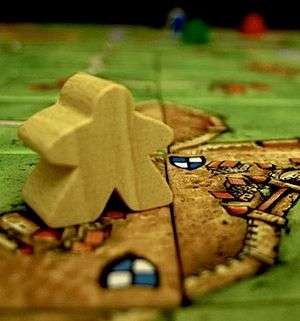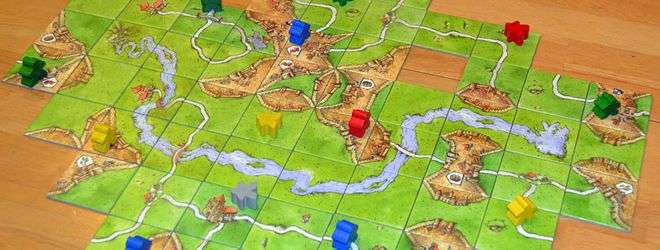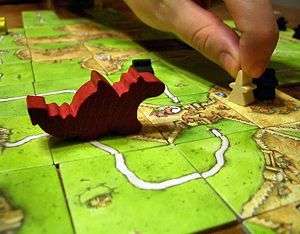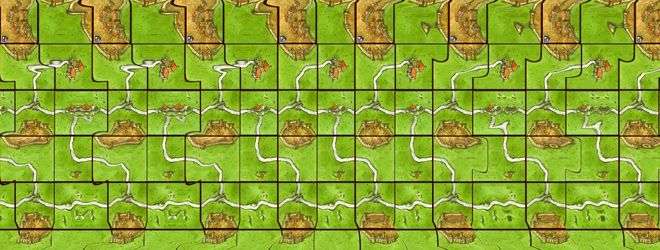Acoustic Gaming: Carcassonne
by Ste
|
 Ask any board gamer to suggest a good starter tabletop game and chances are that Carcassonne will be brought up. Winner of the coveted Spiel des Jahres award for best game in 2001, Carcassonne has reportedly since sold over 10 million units, spawned expansion upon expansion, and had a couple of different themed editions released, the latest of which is a Star Wars version of the game.
Ask any board gamer to suggest a good starter tabletop game and chances are that Carcassonne will be brought up. Winner of the coveted Spiel des Jahres award for best game in 2001, Carcassonne has reportedly since sold over 10 million units, spawned expansion upon expansion, and had a couple of different themed editions released, the latest of which is a Star Wars version of the game.
Designed by Klaus-Jürgen Wrede and currently published by Z-Man Games, Carcassonne is a tile laying game for 2-5 players based on the French medieval walled city of Carcassonne. Players take turns to pick up a tile and place it on the table in order to build their own version of the town. Each tile will be illustrated with either a part of a walled town, a road, a cloister (church type building), or sometimes a combination of all three. Every tile will also be surrounded by grass which, if you can’t find somewhere for your tile to go, will normally allow you to place it next to another tile via the grass edge.
Expansion packs add other features such as a river but for now I’ll concentrate solely on the vanilla version of the game. The tile which will have been selected blindly must then be placed next to another tile on the table, and so the town grows. However the tiles can’t just be placed anywhere, they need to fit in with the tiles which have been laid previously. For example, a tile with a road on it must connect to another tile with another road on it, and a city must be placed next to another city. You get the idea. So although 99.99% of the time you will be able to place your tile, on the very rare occasion you can’t, simply discard that one and pick up another.

Once a tile has been laid, the player has the opportunity to claim any of the features shown on the tile with one of their “Meeples”, which are little wooden pieces shaped like people. Once claimed by a Meeple, that feature is controlled by it, and points are scored once it has been completed. For each of the three features completion means something different:
- Roads are completed by having two logical ends to the road. For example one end of the road could end at a town while the other terminates at a cloister. The player in control of this road will then get one point per tile, the longer the road the more points.
- Towns are completed when the wall surrounding the town has been sealed off. The player would then score two points for every tile, with two bonus points for tiles with a shield symbol on them.
- Cloisters are completed when the tile has been boxed in on every side, including the corners (eight tiles in total). A completed Cloister would score nine points.
 There is one final way to use your Meeple and that is to put one down in a field. Fields make up the green areas between the features on the tiles. However, fields can only be scored at the very end of the game and therefore once put down can’t be reused. Additionally, placing Meeples in fields does not always guarantee you points and the way in which they are scored can be quite difficult to work out. The principle is that three points are given for every completed town that borders that field. However with roads criss-crossing and dissecting fields, and multiple Meeples in the same field, it can sometimes be difficult to tell who is scoring what. As such, a lot of people, me included, tend not to bother with fields. However when they are played, a well-placed Meeple can end up making all the difference.
There is one final way to use your Meeple and that is to put one down in a field. Fields make up the green areas between the features on the tiles. However, fields can only be scored at the very end of the game and therefore once put down can’t be reused. Additionally, placing Meeples in fields does not always guarantee you points and the way in which they are scored can be quite difficult to work out. The principle is that three points are given for every completed town that borders that field. However with roads criss-crossing and dissecting fields, and multiple Meeples in the same field, it can sometimes be difficult to tell who is scoring what. As such, a lot of people, me included, tend not to bother with fields. However when they are played, a well-placed Meeple can end up making all the difference.
Players will each have seven Meeples to begin with, and once one has been used to claim something it is stuck there until the feature has been completed, at which point the Meeple is returned and the points are added to the score track. Players will have to carefully manage their Meeples in order to consistently score points but without leaving themselves short of a Meeple when a good opportunity to play one arises.
To add further strategy, players can try to steal control of roads, towns, and even fields away from their fellow players. Normally once a town/road is claimed by a player’s Meeple it is theirs, however if an opponent were to start a new town/road nearby with their own Meeple and then later connect the two up they would both get the points for the completed feature. If that second player were to get a second Meeple in on the act and then go on to complete they would then steal all the points and the first player would get nothing. This little tug of war between players is a lot of fun which adds an element of “screw you!” to the proceedings, especially during two player games, which tend to be pretty high scoring games. The game continues until all tiles have been laid, at which point bonus points for uncompleted features and fields (if in play) are assigned and then the winner is crowned.

Hey, remember stereograms?
The version of the game I had was the 2015 edition, this version also includes the River and Abbots mini expansions. The tile pieces themselves are made from very thick card stock, so are of very good quality. They are very durable and can withstand a fair bit of playtime before you’ll even start to notice any wear and tear in them. The artwork on the tiles is also very good, with lots of little details added to the features, such as flags on the towns and flowers in the fields. The Meeples themselves are made from solid wood and then painted good vibrant colours and, like the tiles, they look great and it’s no wonder that they’ve gone on to cult status in the board gaming world. Finally, the score board is also very well presented and made from good thick card; it also has the same great art style as the tiles and allows easy tracking of the current score.
Games tend to take about thirty minutes, and you may find yourself pleasantly surprised by how much fun is to be had playing this. Additionally, no two games will ever be quite the same due to the near-limitless forms the build-it-yourself game board can shape into. It is also incredibly simple to teach and learn, new players, young and old(er) will be up and running within a few tiles. This simplicity is probably a major factor in the success and popularity of Carcassonne, however after a while you will probably find yourself wanting to play something with a bit more depth, which, along with the difficulty in scoring fields, is Carcassonne’s only downside. This shouldn’t be a reason not to play or own it though, I know board gamers who have had this since Carcassonne’s original release and it still gets played on occasion. Also the addition of a few expansions go some way in helping to keep the game fresh, especially as all of them are generally compatible with each other. This can only be proof that Carcassonne truly is a classic in the board gaming world and should be played by everyone who likes having fun.
Pros- Simple to teach and learn
- Great components and the home of the iconic Meeple
- Tile laying premise means no two games are ever the same
- Stealing mechanic can make the game quite competitive
- Perfect play time
- Can get a bit samey unless you start buying expansions
- Fields can be difficult/confusing to score
Carcassonne is a fantastic game. Deceptively simply but surprisingly fun, this game gets more than its fair share of play time in my house and will continue to do so in the future. With near limitless replayability, no two games will ever be quite the same, and the many expansions currently available will help to keep the game fresh if you do start to get bored. I can’t recommend Carcassonne enough, especially if you’re relatively new to the world of modern board gaming and looking for a game to ease you in gently.
Last five articles by Ste
- Acoustic Gaming: X-Wing Miniatures Game - Review
- Acoustic Gaming: Pandemic Legacy – Season One
- Bored Gaming
- U Wot Mate?
- Tabletop Simulator - Review























I love Carcassone the most on the 360. Scoring a game at the end would be my worst nightmare though.
Never one I’ve tried but heard loads about!
Like Richie, I also fucking loved this on the 360 and actually maxed it. Great game. The only thing off-putting about the boardgame (which I have but have never yet played), would be the mental scoring at the end. I expect it to take about fifty years.
The scoring isn’t actually that bad. It does take a few minutes but the hardest part is working out the fields. The solution of course is to just not play fields but I suppose that’s only a half measure.